مقدمة لعمليات الفصل التحليلي
Introduction to Analytical Separation
( Sections 22.1 – 22.5, Quantitative Chemical Analysis by Daniel C. Harris, 8th Edition )
( التحليل الكيميائي النوعي – دانيال هاريس )
22 – 1 استخلاص المذيب
22 – 1 Solvent Extraction
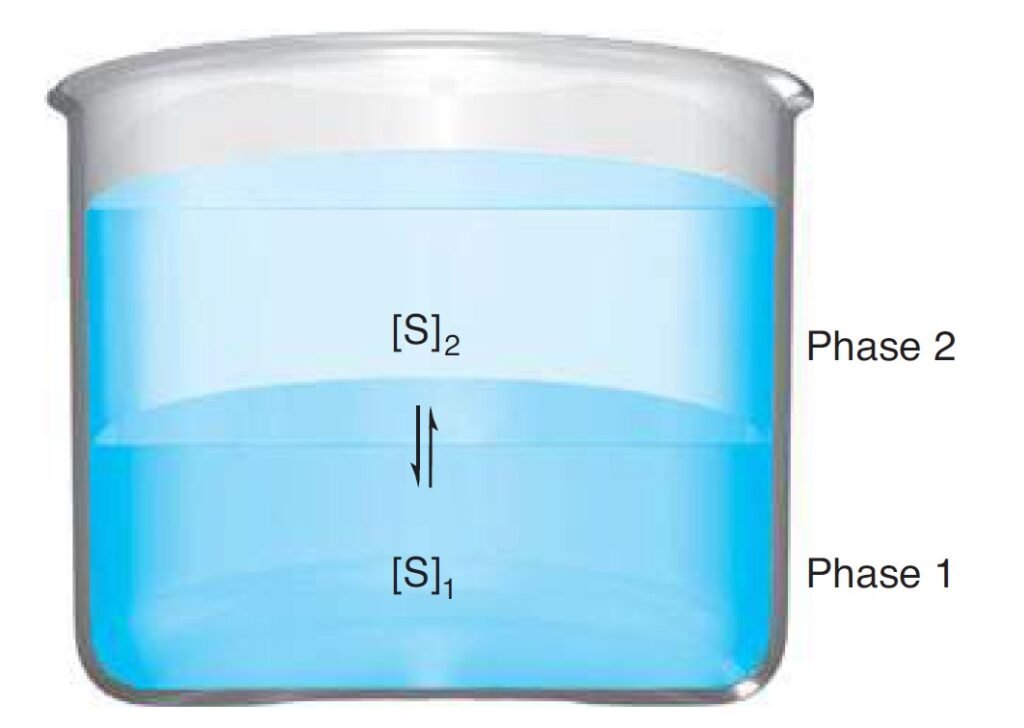 Extraction is the transfer of a solute from one phase to another to isolate or concentrate the desired analyte or to separate it from species that would interfere in the analysis.
Extraction is the transfer of a solute from one phase to another to isolate or concentrate the desired analyte or to separate it from species that would interfere in the analysis.
الاستخراج هو نقل المذاب من طور إلى آخر لعزل أو زيادة تركيز المادة المراد تحليلها أو المطلوبة لفصلها عن الجسمات أو الدقائق الأخرى التي قد تتداخل في التحليل.
The two phases used can be liquid-liquid, liquid-solid, gas-solid, etc, which liquid-liquid is the most common type of extraction.
فكلا الطورين يمكن أن يكونا سائل-سائل أو سائل-صلب أو غاز صلب …الخ ، و أكثر أنواع الاستخلاص شيوعا هو من نوع السائل-السائل.
The most common case is the extraction of an aqueous solution with an organic solvent as diethyl ether, toluene, and hexane which are immiscible and less dense than water and floats on top of the aqueous phase
الحالة الأكثر شيوعًا لعملية الاستخلاص هي استخلاص محلول مائي بمذيب عضوي مثل إيثيل إيثر ، والتولوين ، والهكسان ، والتي هي غير قابلة للامتزاج وأقل كثافة من الماء حيث تطفو فوق الطور المائي.
In the two-phase mixture, one phase is predominantly water and the other phase is predominantly organic.
في الخليط المكون من طورين، الطور الاول يكون عبارة عن ماء في الغالب بينما يكون الطور الآخر عضوي في الغالب.
If a solute S is partitioned between phases 1 and 2, the partition coefficient, K, is the equilibrium constant for the reaction:
إذا تم تقاسم المذاب S بين المرحلتين 1 و 2 ، فإن معامل التقاسم (أو معامل التقسيم) ، K ، هو ثابت الإتزان للتفاعل:

where As1 refers to the activity of solute in phase 1.
حيث As1 هي فعالية المذاب في الطور الأول.
Suppose that solute S in V1 mL of solvent 1 (water) is extracted with V2 mL of solvent 2 (toluene). Let m be the moles of S in the system and let q be the fraction of S remaining in phase 1 at equilibrium. The molarity in phase 1 is therefore qm/V1. The fraction of total solute transferred to phase 2 is (1 – q), and the molarity in phase 2 is (1 – q)m/V2. Therefore,
افترض أن هناك مذابا نرمز له بالرمز S يوجد في المذيب 1 (الماء على سبيل المثال) و حجم هذا المذيب (الطور1) يساوي V1 مل ويتم استخلاصه باستخدام مذيب عضوي و يمثل الطور 2 (التولوين مثلا) حجمه V2 مل . و افتللرض أيضا أن m هي عدد مولات المذاب S في النظام، و ان q هو جزء من المذاب S المتبقي في الطور1 عند الإتزان. وبالتالي فإن المولارية في الطور 1 هي qm / V1، و جزء المذاب الكلي المنقول إلى الطور الثاني هو (1 – q) ، والمولارية في المرحلة 2 هي ![]() . لذلك،
. لذلك،


If the phases are separated and fresh toluene (solvent 2) is added, the fraction of solute remaining in the water at equilibrium will be
فإذا ما تم فصل الاطوار وإضافة تولوين جديد (المذيب 2) ، فإن جزء المذاب المتبقي في الماء عند الإتزان سيكون:

The fraction of S remaining in phase 1 after n extractions is
الكمية الباقية S المتبقية في الطور الأول بعد عدد من الاستخلاصات n :

pH Effects تأثير الرقم الهيدروجيني
The distribution of a weak base or weak acid in the two phases is pH dependent.
يعتمد مدى توزيع الحمض الضعيف أو القاعدة الضعيفة بين طوري الاستخلاص على درجة الرقم الهيدروجيني pH .
A neutral species is more soluble in an organic solvent and a charged species is more soluble in aqueous solution.
الجسيمات أو الدقائق المتعادلة أكثر ذوبانا في المذيب العضوي بينما الجسيمات أو الدقائق التي تحمل شحنة موجبة أو سالبة فإنها اكثر ذوبانا في المذيب المائي.
A base whose neutral form, B, has partition coefficient K between aqueous phase 1 and organic phase 2.
فلو فرضنا أن هناك قاعدة متعادلة (مذاب قاعدي متعادل) فإنه سيكون لهذه القاعدة معامل تقاسم (أو معامل تقسيم) K بين الطور الأول المائي و الطور الثاني العضوي.
A conjugate acid of a base , BH+, is soluble only in aqueous phase 1. and its constant as Ka. The distribution coefficient, D, is defined as
أما الحمض المرافق لهذه القاعدة BH+ فإنه سيكون قابلا للذوبان في الطور المائي أي الطور الأول ، فلو افترضنا أن معامل التقسيم له يساوي Ka فإن معامل التوزيع D سيكون:

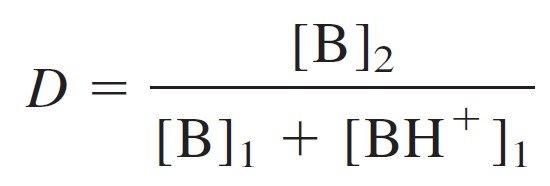

where αB is the fraction of weak base in the neutral form, B, in the aqueous phase.
حيث αB يمثل ذلك الجزء من القاعدة الضعيفة في الشكل المتعادل الموجودة في الطور المائي.
The ability to change the distribution ratio of a acid or base with pH is useful in selecting conditions that will extract some compounds but not others.
إن القدرة على تغيير نسبة توزيع الحمض أو القاعدة اعتمادا على التحكم بالرقم هيدروجيني مفيد في اختيار الظروف التي ستستخلص بعض المركبات دون غيرها.
To extract a base into water, use a pH low enough to convert B into BH+.
لاستخلاص القاعدة في الطور المائي قم بذلك عند رقم هيدروجيني منخفض و ذلك لتحويل القاعدة B إلى الحمض المرافق لها +BH .
To extract the acid HA into water, use a pH high enough to convert HA into A–.
لاستخلاص الحمض في الطور المائي قم بذلك عند رقم هيدروجيني مرتفع و ذلك لتحويل الحمض A إلى الحمض المرافق لها –A .
Extraction with a Metal Chelator الاستخلاص بوجود فلز يشكل معقدا
Most complexes that can be extracted into organic solvents are neutral. Charged complexes are not very soluble in organic solvents.
معظم المعقدات التي يمكن استخلاصها إلى مذيبات عضوية تكون متعادلة. أما المعقدات التي تحمل شحنة موجبة أو سالبة فإنها ليست قابلة للذوبان في المذيبات العضوية.
For separating metal ions from one another is to selectively complex one ion with an organic ligand and extract it into an organic solvent.
لفصل أيونات الفلزات عن بعضها البعض ، يتم تشكيل معقد انتقائي مع الايون المراد فصله باستخدام ربيطة أو لاقط عضوي و استخلاصه في مذيب عضوي.
For this purpose we can use Ligands such as dithizone or 8-hydroxyquinoline, or cupferron. Each is a weak acid, HL, which loses a proton when it binds to a metal ion.
و لهذه الغاية يمكن استخدام ربيطات أو لواقط مثل : الديثيزون أو 8-هيدروكسي كينولين أو الكبفيرون. و كل منها يُعدّ حمضا ضعيفا HL و التي يمكن لها أن تفقد بروتونا عندما ترتبط مع أيون الفلز.

The distribution coefficient of a metal between two phases when essentially all the metal in the aqueous phase (aq) is in the form Mn+ and all the metal in the organic phase (org) is in the form MLn:
معامل توزيع الفلز بين الطورين عندما يكون كل الفلز في الطور المائي (aq) على شكل +Mn ويكون كل الفلز في الطور العضوي (org) على شكل MLn:
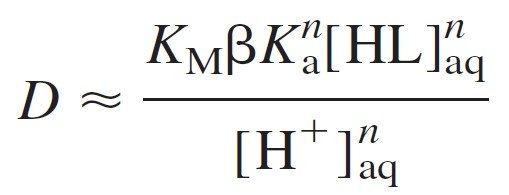
22 – 2 ما هي الكروماتغرافيا (الاستشراب)
22 – 2 What Is Chromatography?
Chromatography is a separation technique based on the different rates of travel of solutes through a system composed of two phases a stationary phase and mobile phase.
الكروماتوغرافيا هي تقنية فصل تعتمد على معدلات الانتقالات المختلفة للمواد المذابة من خلال نظام يتكون من طورين : الطور الثابت و الطور المتحرك .
The mobile phase (the solvent moving through the column) in chromatography is either a liquid or a gas.
الطور المتحرك (المذيب الذي يتحرك خلال العمود) في الكروماتوغرافيا هو إما سائل أو غاز.
The stationary phase (the one that stays in place inside the column) is most commonly a viscous liquid chemically bonded to the inside of a capillary tube or onto the surface of solid particles packed in the column.
الطور الثابت (الذي يبقى في مكانه داخل العمود) هو في الغالب سائل لزج مرتبط كيميائيًا بداخل الأنبوب الشعري أو على سطح الجسيمات الصلبة المعبأة في العمود.
Support is solid onto which the stationary phase is chemically attached or coated
المادة الداعمة هي مادة صلبة بحيث يرتبط بها الطور المتحرك.
![]()
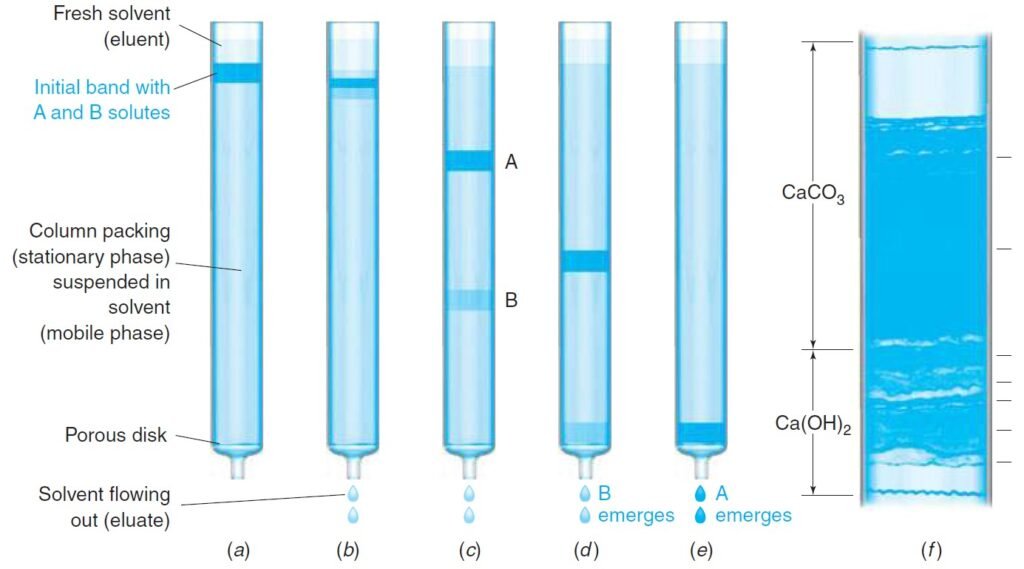
Elution: The process of passing liquid or gas through a chromatography column.
فصل تتابعي ( تمليص ) أو استنقاء : هي عملية مرور السائل أو الغاز خلال عمود\ الكروماتوغرافيا.
Types of Chromatography أنواع الكروماتوغرافيا
Adsorption chromatography. A stationary phase is solid and the mobile phase is a liquid or gaseous. Solute is adsorbed on the surface of the solid particles. The more strongly a solute is adsorbed, the slower it travels through the column.
كروماتوغرافيا الامتزاز. الطور الثابت يكون صلبا والطور المتحرك يكون سائلا أو غازيا. في هذا النوع من الكروماتوغرافيا يتم امتزاز المذاب على سطح الجسيمات الصلبة، فكلما زادت قوة امتزاز المادة المذابة ، كان انتقالها أبطأ عبر العمود.
Partition chromatography. A stationary phase is a liquid bonded to a solid surface, which is typically the inside of the silica (SiO2) chromatography column in gas chromatography. Solute equilibrates between the stationary liquid and the mobile phase, which is a flowing gas in gas chromatography.
كروماتوغرافيا التقسيم. هنا يكون الطور الثابت عبارة عن سائل مرتبط بسطح صلب ، والذي يكون عادةً داخل عمود السيليكا (SiO2) في جهاز كروماتوغرافيا الغاز، و الطور المتحرك هو غاز متدفق في كروماتوغرافيا الغاز. تتوازن أو تتقاسم المادة المذابة بين السائل الثابت و الطور المتحرك .
Ion-exchange chromatography. Anions such as —SO3– or cations such as —N(CH3)3+ are covalently attached to the stationary solid phase, usually a resin. Solute ions of the opposite charge are attracted to the stationary phase. The mobile phase is a liquid.
كروماتوغرافيا التبادل الأيوني. الأنيونات مثل –SO3— أو الكاتيونات مثل +N(CH3)3— تكون مرتبطة تساهميًا بالطور الصلب الثابت ، وعادة ما يكون راتينج. تنجذب أيونات المادة المذابة من الأيونات العاكسة لها بالشحنة في الطور الثابت. أما الطور المتحرك عبارة عن سائل.
Molecular exclusion chromatography. Also called size exclusion, gel filtration, or gel permeation chromatography, this technique separates molecules by size, with the larger solutes passing through most quickly. In the ideal case of molecular exclusion, there is no attractive interaction between the stationary phase and the solute. Rather, the liquid or gaseous mobile phase passes through a porous gel. The pores are small enough to exclude large solute molecules but not small ones. Large molecules stream past without entering the pores. Small molecules take longer to pass through the column because they enter the gel and therefore must flow through a larger volume before leaving the column.
كروماتوغرافيا الاستقصاء الجزيئي. تُسمى أيضًا بكروماتوغرافيا استبعاد الحجم ، أو كروماتوغرافيا الترشيح الهلامي ، أو كروماتوغرافيا تغلغل الهلام ، و في هذه التقنية يتم فصل الجزيئات حسب الحجم ، مع مرور المواد المذابة الأكبر بسرعة أكبر. في حالة الاستقصاء الجزيئي المثالي ، لا يوجد تفاعل تجاذب بين الطور الثابت والمذاب. و لكن بدلاً من ذلك، يمر الطور المتحرك السائل أو الغازي عبر هلام مسامي. فالمسامات صغيرة بما يكفي لاستبعاد جزيئات الذائبة الكبيرة ولكن ليست صغيرة. فالجزيبئات الكبيرة تتدفق دون دخولها المسام. و هنا تستغرق الجزيئات الصغيرة وقتًا أطول لتمريرها عبر العمود لأنها تدخل الهلام وبالتالي يجب أن تتدفق خلال حجم أكبر للهلام قبل مغادرة العمود.
Affinity chromatography. This most selective kind of chromatography employs specific interactions between one kind of solute molecule and a second molecule that is covalently attached (immobilized) to the stationary phase. For example, the immobilized molecule might be an antibody to a particular protein. When a mixture containing a thousand proteins is passed through the column, only the one protein that reacts with the antibody binds to the column. After all other solutes have been washed from the column, the desired protein is dislodged by changing the pH or ionic strength.
كروماتوغرافيا التآلف. يستخدم هذا النوع الأكثر انتقائية من الكروماتوغرافيا تفاعلات محددة بين نوع واحد من جزيء المذاب وجزيء ثانٍ مرتبط تساهميًا (مثبتة) بالطور الثابت. على سبيل المثال ، قد يكون الجزيء المبطيء لحركة المذاب جسمًا مضادًا لبروتين معين. فعندما يتم تمرير خليط يحتوي على آلاف البروتينات عبر العمود ، فإن البروتين الوحيد الذي يتفاعل مع الجسم المضاد يرتبط بالعمود. و بعد غسل جميع المواد المذابة الأخرى من العمود ، يتم إزاحة البروتين المطلوب عن طريق تغيير درجة الحموضة أو القوة الأيونية.
22 – 3 نظرة مفصلة حو الكروماتوغرافيا
22 – 3 A Plumber’s View of Chromatography
Chromatogram: graph showing the detector response as a function of elution time.
الكروماتوغرام: هو مخطط يظهر مدى استجابة المكشاف كدالة زمنية لتحرك المادة المراد تحليها خلال الطور المتحرك.

Retention time (tr): the time it takes a compound to pass through a column.
وقت الاستبقاء (tr): الوقت الذي يستغرقه المركب للمرور خلال أو عبر العمود.
Retention volume (Vr): volume of mobile phase needed to push solute through the column.
حجم الاستبقاء (Vr): حجم الطور المتحرك اللازم لدفع المذاب عبر العمود.
Mobile phase or an unretained solute travels through the column in the minimum possible time, tm.
يميل الطور المتحرك أو جزيئات المذاب غير المحتجزة “الحرة” على المرور خلال العمود في أقل وقت ممكن tm .
The adjusted retention time, t’r, for a retained solute is the additional time required to travel the length of the column, beyond that required by solvent:
أما وقت الاستبقاء المعدل t’r لجزيئات المذاب المحتجزة فإنه الوقت الإضافي اللازم للمرور على طول العمود بجانب ذلك الوقت اللازم للمذيب :
![]()
For two components 1 and 2, the relative retention, α (also called separation factor), is the ratio of their adjusted retention times:
للمكونين 1 و 2 فإن زمن الاستبقاء النسبي α ( و الذي يسمى أيضا معامل الفصل) هي النسبة لأزمنة الاستبقاء المعدلة الخاصة بهما:

Where: t’r2 > t’r1 , so, α > 1
Greater the relative retention the greater the separation between two components.
كلما زاد زمن الاستبقاء النسبي زاد الفصل بين مكونين.
For component 2 eluted after component 1, the unadjusted relative retention, γ, is the ratio of their unadjusted retention times:
للمكون الثاني الذي يتم استخلاصه بعد المكون الاول، فإن زمن الاستبقاء النسبي غير المعدل γ هي النسبة لاستبقاء غير المعدلة الخاصة بهم:

Retention factor, k, is the time required to elute that peak tr minus the time tm required for mobile phase to pass through the column, expressed in multiples of tm.
معامل الاستبقاء k هو الزمن اللازم للمادة المراد استخلاصها للوصول إلى قصى مسافة لها tr مطروحًا منها الوقت tm المطلوب لتحرك الطور المتحرك عبر العمود ، معبرًا عنه بمضاعفات tm.

The longer a component is retained by the column, the greater is the retention factor.
فكلما زاد زمن استبقاء المكون في العمود ، كان معامل الاستبقاء أكبر.
العلاقة بين زمن الاستبقاء و معامل التقسيم
Relation Between Retention Time and the Partition Coefficient

Where, cs is the concentration of solute in the stationary phase, Vs is the volume of the stationary phase, cm is the concentration of solute in the mobile phase, and Vm is the volume of the mobile phase.
حيث ، cs هو تركيز المذاب في المرحلة الثابتة ، Vs هو حجم الطور الثابت ، cm هو تركيز المذاب في الطور المتحرك ، و Vm هو حجم الطور المتحرك.
Since, t’r ∝ k ∝ K, the relative retention can also be expressed as
و حيث أن t’r ∝ k ∝ K فإن زمن الاستبقاء النسبي يمكن التعبير عنه كما يأتي:

Retention volume, Vr, is the volume of mobile phase required to elute a particular solute from the column:
الحجم المستبقي Vr : هو حجم الطور المتحرك اللازم لتحريك مذاب معين من العمود:
![]()
Scaling Up تضخيم أو تكبير عمليات الفصل الكروماتوغرافي
The most straightforward way to scale up is to maintain the same column length and to increase the cross-sectional area to maintain a constant ratio of sample mass to column volume. Cross sectional area is πr2, where r is the column radius, so the desired diameter is given by:
الطريقة الأكثر وضوحا لتكبير أو لتضخيم عملية الفصل الكروماتوغرافي لتتماشى مع الحجوم أو الأوزان الكبيرة هي الحفاظ على طول العمود نفسه وزيادة مساحة المقطع العرضي للحفاظ على نسبة ثابتة من كتلة العينة إلى حجم العمود. فمساحة المقطع العرضي هي πr2 ، حيث r هو نصف قطر العمود ، لذلك يتم حساب القطر المطلوب من خلال:

22 – 4 كفاءة الفصل
22 – 4 Efficiency of Separation
Two factors contribute to how well compounds are separated by chromatography.
- The difference in elution times between peaks: The farther apart, the better their separation.
- How broad the peaks are: the wider the peaks, the poorer their separation.
هناك عاملان يحددان مدى فصل المكونات عن بعضها البعض في الكرومكاتوغرافيا:
1 – الفارق الزمني بين أوقات الفصل و يظهر ذلك على شكل قمم في الرسم البياني. فكلما كانت القمم متباعدة أكثر كان الفصل أكثر نجاعة .
2 – مدى عرض القمم ، فكلما كانت القمة أكثر عرضا كانت فرصة الفصل أضعف.
Resolution الدقة
The width of a solute peak is important in determining how well one solute is separated from another
إن عرض قمة المذاب يُعد هاما لتعيين أو لتبيان ما مدى نجاعة فصل مذاب عن آخر .
One measure of this is the width of the peak at half-height w½ or at its baseline wb.
فأحد دلائل ذلك هو عرض القمة عند منتصفها ½w أو عند خط الأساس wb .
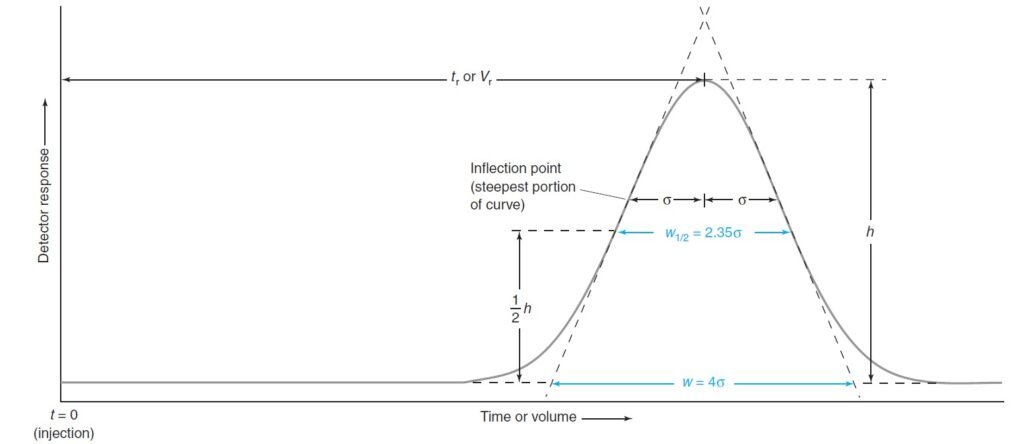
The separation of two solutes in chromatography depends both on the width of the peaks and their degree of retention.
كما أن فصل مذابين في الكروماتوغرافيا يعتمد كلاهما على عرض القمم و على درجة الاستبقاء الخاصة بهما .
The separation between the two solutes is given by their Resolution (Rs)
كما أن الفصل بين كلا المذابين يحسب من خلال مدى دقة Rs كل منهما.
Resolution (Rs) is defined as:
و تعرف الدقة Rs كما ياتي :

where Δtr or ΔVr is the separation between peaks (in units of time or volume) and wav is the average width of the two peaks in corresponding units.
حيث Δtr أو ΔVr هو الفاصل بين القمم (بوحدات الوقت أو الحجم) و wav هو متوسط عرض القمتين بالوحدات المقابلة.
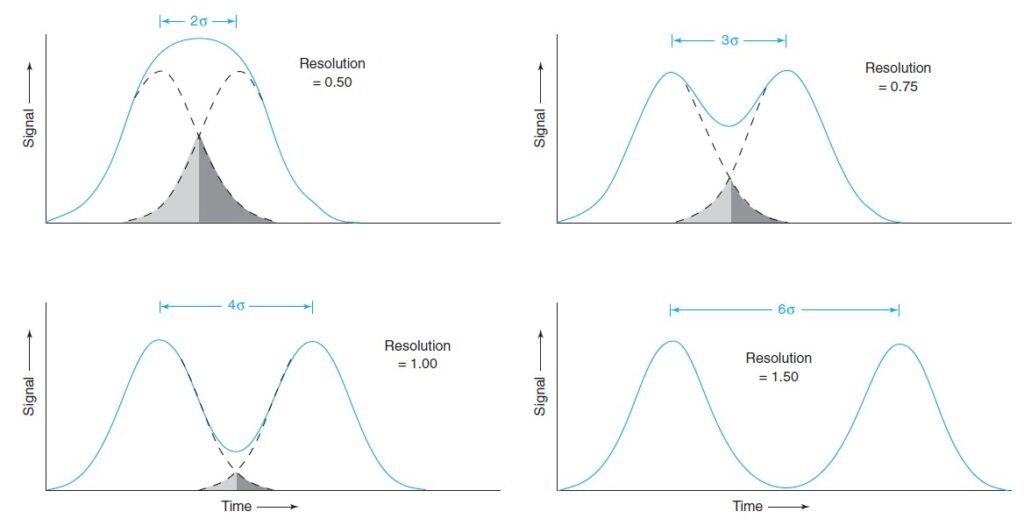
Diffusion الانتشار
The diffusion coefficient measures the rate at which molecules move randomly from a region of high concentration to a region of low concentration. The number of moles crossing each square meter per second, called the flux, J, is proportional to the concentration gradient:
يقيس معامل الانتشار المعدل الذي تنتقل به الجزيئات عشوائيًا من منطقة ذات تركيز عالٍ إلى منطقة تركيز منخفض. حيث يتناسب عدد المولات التي تعبر كل متر مربع في الثانية و الذي يعرف بـ التدفق ، J ، مع تدرج التركيز كما ياتي:

The constant of proportionality, D, is the diffusion coefficient, and the negative sign is necessary because the net flux is from the region of high concentration to the region of low concentration.
و ثابت التناسب D هو معامل الانتشار و علامة أو إشارة السالب ضرورية لأن صافي التدفق هو من منطقة التركيز العالي إلى منطقة التركيز المنخفض.

If solute begins its journey through a column in an infinitely sharp layer with m moles per unit cross-sectional area of the column and spreads by diffusion as it travels, then the Gaussian profile of the band is described by:
إذا بدأ المذاب رحلته عبر عمود في طبقة لا متناهية الحدة مع m مولات لكل وحدة مساحة للمقطع العرضي للعمود و يتمدد بالانتشار أثناء انتقاله ، فسيتم وصف المظهر الجانبي الغوسي للحزمة بواسطة:

where c is concentration (mol/m3), t is time, and x is the distance along the column from the current center of the band.
حيث c هو التركيز (مول/متر مكعب) ، و t هو الوقت ، و x هي المسافة على طول العمود من المركز الحالي للحزمة.
![]()
ارتفاع الشريحة (الطبقة): مقياس كفاءة العمود
Plate Height: A Measure of Column Efficiency
If solute has traveled a distance x at the linear flow rate ux(m/s), then the time it has been on the column is t = x/ux. Therefore,
إذا ما سار المذاب مسافة x بمعدل تدفق خطي يساوي ux(m/s) فإن زمن وجوده في العمود t يساوي x/ux ، لذلك:

Plate height, H, is the constant of proportionality between the variance, σ2, of the band and the distance it has traveled, x. The name came from the theory of distillation in which separation could be performed in discrete stages called plates. The smaller the plate height, the narrower the bandwidth.
ارتفاع الشريحة (الطبقة) H : هو ثابت التناسب بين التباين σ2 للحزمة و المسافة التي قطعتها x. و جاء اسم “الشريحة” من نظرية التقطير التي يمكن من خلالها إجراء الفصل في مراحل منفصلة تسمى الشرائح (الطبقات). فكلما كان ارتفاع اللوحة أصغر ، قل عرض الحزمة.
The ability of a column to separate components of a mixture is improved by decreasing plate height. An efficient column has more theoretical plates than an inefficient column.
يتم تحسين قدرة العمود على فصل مكونات الخليط عن طريق التقليل ارتفاع الشريحة (الطبقة). فالعمود الفعال يحتوي على شرائح (طبقات) نظرية أكثر من العمود غير الفعال.
Plate heights are ∼0.1 to 1 mm in gas chromatography, ∼10 μm in high-performance liquid chromatography, and 1 <m in capillary electrophoresis.
ارتفاع الشرائح (الطبقات) هي 0.1 إلى 1 مم في كروماتوغرافيا الغاز ، و 10 ميكرومتر في كروماتوغرافيا السائل عالية الأداء ، و و أقل من 1 ميكرومتر في الرحلان الكهربي الشعري.
Plate height is the length σ2/x, where σ is the standard deviation of the Gaussian band and x is the distance traveled. For solute emerging from a column of length L, the number of plates, N, in the entire column is the length L divided by the plate height:
ارتفاع الشريحة (الطبقة) هو الطول σ2/x ، حيث σ هو الانحراف المعياري لحزمة غاوسي و x هي المسافة المقطوعة. و بالنسبة للمذاب الخارج من عمود ذو الطول L ، فإن عدد الشرائح (الطبقات)، N ، في العمود بأكمله هو الطول L مقسومًا على ارتفاع الشريحة (الطبقة):

because x = L and σ=w/4. If we express L and w (or σ) in units of time instead of length, N is still dimensionless. We obtain a useful expression for N by writing:
وذلك لأن x = L و σ تساوي w / 4. فإذا عبرنا عن L و w (أو σ) بوحدات زمنية بدلاً من الطول ، فإن N لا يزال بلا أبعاد. و هنا نحصل على معادجلة مفيدة لـ N و هي :

where tr is the retention time of the peak and w is the width at the base in units of time. If we use the width at half-height, also called the half-width, instead of the width at the base, we get
حيث tr هو وقت استبقاء القمة و w هو العرض عند خط الاساس بوحدات الزمن. فإذا استخدمنا العرض عند نصف الارتفاع و الذي يسمى أيضًا نصف العرض ، بدلاً من العرض عند خط الأساس ، نحصل على :

Factors Affecting Resolution العوامل التي تؤثر على الدقة
For two closely spaced, symmetric peaks, the relation between plates and resolution is:
بالنسبة لقمتين متماثلتين و متقاربتين ، فإن العلاقة بين الشرائح (الطبقات) والدقة هي:

Where N is the number of theoretical plates and γ is the unadjusted relative retention.
حيث N هو عدد الشرائح النظرية و γ الاستبقاء النسبي غير المعدل.
From the above equation we find that the resolution is proportional to ![]() . Therefore, doubling the column length increases resolution by
. Therefore, doubling the column length increases resolution by ![]() .
.
فمن العلاقة السابقة نجد أن الدقة تتناسب مع ![]() ، لذلك فإن زيادة طول العمود إلى الضعف يعمل على زيادة الدقة بمعدل
، لذلك فإن زيادة طول العمود إلى الضعف يعمل على زيادة الدقة بمعدل ![]() .
.
Also the last equation tells us that resolution increases as the unadjusted relative retention γ increases. The unadjusted relative retention is the relative velocity of the two components through the column. The way to change relative velocity is to change the stationary phase in gas chromatography or either the stationary or the mobile phase in liquid chromatography.
و تخبرنا المعادلة الأخيرة أيضًا أن الدقة تزداد مع زيادة الاستبقاء النسبي غير المعدل γ. فالاستبقاء النسبي غير المعدل هو السرعة النسبية للمكونين عبر العمود. و تتمثل طريقة تغيير السرعة النسبية هي في تغيير الطور الثابت في كروماتوغرافيا الغاز أو إما الطور الثابت أو المتنقل في كروماتوغرافيا السائل.
22 – 5 سبب تواسع الحزم
22 -5 Why Bands Spread
A band of solute invariably spreads as it travels through a chromatography column and emerges at the detector with a standard deviation σ. Each individual mechanism contributing to broadening produces a standard deviation σi. The observed variance (σ2obs) is the sum of variances from all contributing mechanisms:
تنتشر حزمة المادة المذابة دائمًا أثناء انتقالها عبر عمود الكروماتوجرافيا وتظهر عند المكشاف بانحراف معياري مقداره σ. فكل آلية فردية تساهم في التواسع تنتج انحرافًا معياريًا مقداره σi. فالتباين الملحوظ (σ2obs) هو مجموع الفروق من جميع الآليات المساهمة:
![]()
التواسع خارج العمود
Broadening Outside the Column
Solute cannot be applied to the column in an infinitesimally thin zone, so the band has a finite width even before it enters the column. The contribution to the variance of the final bandwidth is:
لا يمكن إدخال المذاب على العمود ضمن نطاق ضيق متناهي في الصغر ، لذا فإن الحزمة لها عرض محدود حتى قبل أن تدخل المادة المذابة العمود. لذلك فإن المساهمة في تباين عرض الحزمة النهائي هي:

Plate Height Equation معادلة ارتفاع الشريحة (الطبقة)
Plate height, H, is proportional to the variance of a chromatographic band, the smaller the plate height, the narrower the band. The van Deemter equation tells us how the column and flow rate affect plate height:
يتناسب ارتفاع الشريحة (الطبقة)، H ، مع تباين الحزم الكروماتوغرافية ، فكلما كان ارتفاع الشريحة (الطبقة) أصغر ، كان الحزمة أضيق. و تخبرنا معادلة فان ديمتر كيف يؤثر العمود و معدل التدفق على ارتفاع الشريحة أو الطبقة:

where ux is the linear flow rate and A, B, and C are constants for a given column and stationary phase. Changing the column and stationary phase changes A, B, and C.
حيث ux هو معدل التدفق الخطي و A و B و C ثوابت لعمود معين و طور ثابت معين . فتغيير العمود والطور الثابت يغير A و B و C.
The van Deemter equation says there are band broadening mechanisms that are proportional to flow rate, inversely proportional to flow rate, and independent of flow rate.
و تخبرنا معادلة فان ديمتر أن هناك آليات لتوسيع الحزم تتناسب مع معدل التدفق و أخرى تتناسب عكسياً مع معدل التدفق و ثالثة لا تتأثر مع معدل التدفق أيضا.
Longitudinal Diffusion الانتشار الطولي
If you could apply a thin, disk-shaped band of solute to the center of a column, the band would slowly broaden as molecules diffuse from the high concentration within the band to regions of lower concentration on the edges of the band. Diffusional broadening of a band, called longitudinal diffusion because it takes place along the axis of the column, occurs while the band is transported along the column by the flow of solvent.
إذا كان بالإمكان وضع حزمة رقيقة من المذاب على شكل قرص في منتصف مركز العمود ، فإن الحزمة ستتوسع ببطء كلما انتشرت الجزيئات من التركيز العالي داخل الحزمة إلى مناطق ذات تركيز أقل على حواف الحزمة. و هنا يحدث التواسع الانتشاري و الذي يعرف باسم الانتشار الطولي لأنه يحدث على طول محور العمود ، أثناء انتقال الحزمة على طول العمود من خلال تدفق المذيب.
The faster the linear flow, the less time is spent in the column and the less diffusional broadening occurs.
فكلما كان التدفق الخطي أسرع ، قل الوقت الذي يقضيه في العمود و بالتالي يحدث توسع أقل في الانتشار.

where Dm is the diffusion coefficient of solute in the mobile phase, t is time, and HD is the plate height due to longitudinal diffusion. The time needed to travel the length of the column is L/ux, where L is the column length and ux is the linear flow rate.
حيث Dm هو معامل انتشار المذاب في الطور المتحرك و t هو الزمن ، و HD هو ارتفاع الشريحة (الطبقة) بسبب الانتشار الطولي. فالوقت اللازم للتنقل بطول العمود هو L/ux ، حيث L هو طول العمود و ux هو معدل التدفق الخطي.
الوقنت المحدود للإتزان بين الأطوار
Finite Equilibration Time Between Phases
The term Cux comes from the finite time required for solute to equilibrate between mobile and stationary phases. Although some solute is stuck in the stationary phase, the remainder in the mobile phase moves forward, spreading the overall zone of solute. Plate height from finite equilibration time, also called the mass transfer term, is:
يأتي المصطلح Cux من الوقت المحدود اللازم للمذاب للإتزان بين الطورين المتحرك و الثابت. و على الرغم من أن بعض المذاب يكون عالقا في الطور الثابت ، فإن الباقي يكون في الطور المتحرك و يتحرك للأمام و يعمل على انتشار النطاق الكلي للمذاب. فارتفاع الشريحة (الطبقة) من الوقت المحدود للإتزان و الذي يسمى أيضًا مصطلح نقل الكتلة ، هو:

For gas chromatography in an open tubular column, the terms are
و في كروماتوغرافيا الغاز و في العمود الأنبوبي (الأسطواني) المُجوَّف فإن :

المصادر:
- Quantitative Chemical Analysis by Daniel C. Harris, 8th Edition
- الموسوعة العلمية الكيميائية للأستاذ أكرم العلي
بوسترات (لوحات) كيميائية بدقة عالية (أكثر من 25 لوحة) من تصميم الأستاذ أكرم أمير العلي
تطبيق ملصقات الجدول الدوري باللغة العربية : بطاقات تحتوي على معلومات شاملة و مختصرة في نفس الوقت كل عنصر على حدة (اللغة العربية).
https://play.google.com/store/apps/details?id=com.akramir2
 مصادر الكيمياء موقع لتعليم الكيمياء بصورة مبسطة
مصادر الكيمياء موقع لتعليم الكيمياء بصورة مبسطة